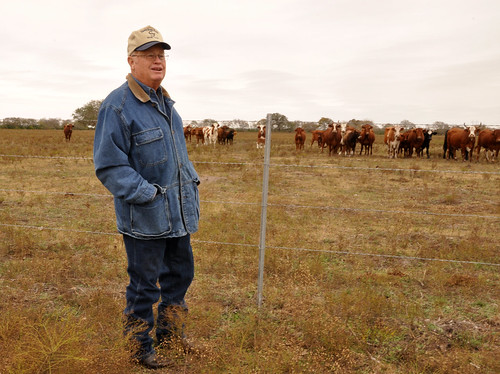
For Texas rancher Dallas Ford and other Gulf Coast landowners, the Gulf of Mexico Initiative means an opportunity to make a positive difference not only on their lands, but also in the inland waters that flow into the Gulf of Mexico.
The Gulf of Mexico Initiative (GoMI) is a new program of USDA’s Natural Resources Conservation Service (NRCS) and many partners. It is designed to help producers in Alabama, Florida, Louisiana, Mississippi and Texas improve water quality and ensure sustainable agriculture production.
Ford, owner of the Smokey Creek Ranch in Tivoli, has been a participant in NRCS conservation programs for many years. He also serves on the Copano Bay Soil and Water Conservation District Board and on the Refugio Groundwater Conservation District Board.
“With this program I have an opportunity to cross fence and rotate cattle,” Ford says. “By having water facilities on the ranch, the cattle won’t have to get down into the creeks to drink, which will help with erosion and the water quality.”
As part of his rotational grazing plan, Ford applied under GOMI to install a water well and a solar pump to supply water to his cattle. These conservation practices will keep the cattle from entering the creek, which can impair water quality.
In Texas, GoMI project areas include the Kuy Creek–Guadalupe River, the Guadalupe River–South Guadalupe River and the Hynes Bay–San Antonio Bay watersheds in Refugio, Calhoun, Victoria and Aransas counties.
The initiative will improve wildlife and fish habitats, including those of some threatened and endangered species, such as the whooping crane. It will also help communities that depend on the Gulf of Mexico for jobs.
Over the next three years, GoMI will provide $50 million to 16 priority watersheds in seven major river basins through a combination of NRCS programs. This investment represents an eleven-fold increase over the current level of conservation assistance in GoMI priority areas. This year $20 million has been allocated for producers in the five Gulf Coast states.
GoMI partners in Texas include the U.S. Fish and Wildlife Service, Texas Parks and Wildlife Department, Texas General Land Office, Coastal Bend Bays and Estuaries Program, Texas State Soil and Water Conservation Board, San Antonio River Authority and U.S. Geological Survey.
Find out more about the Gulf of Mexico Initiative.
Check out more conservation stories on the USDA blog.
Follow NRCS on Twitter.
